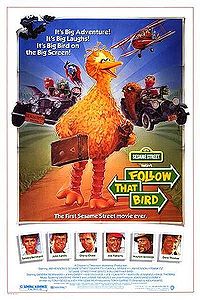
FOLLOW THAT BIRD
US, 1985, 88 minutes, Colour.
Carol Spinney, Jim Henson, Frank Oz, Jerry Nelson, John Cleese, Chevy Chase, Sandra Bernhard, Paul Bartel, Waylon Jennings.
Directed by Ken Kwapis.
Follow That Bird is a delightful entertainment for younger children (which older children mightn't mind and which parents will probably enjoy thoroughly). It is the first feature-length film made by the Sesame Street group and focuses on the familiar and friendly character of Big Bird. A number of the Muppets and humans from the Sesame Street series appear. The film has the entertainment value of the series - as well as the educational and moralising aspects
There are some guest stars including Chevy Chase as a newsreader, John Candy as a policeman and Waylon Jennings singing one of the several songs which punctuate the film.
The screenplay relies on some of the old style movies - the inner cities, the do-gooders, harsh families and adoption, chase films and exploitation - as well, of course, as the happy ending.
1. The popularity of Sesame Street? its long life on American and world television? Entertainment and education? Its being a way of introducing youngsters of the 170s and 180s into the world of screen images?
2. The popularity of Sesame Street, its particularly American style, New York, the settings of this film: the city, Illinois, the American Midwest countryside? The sights, the American types?
3. Audience enjoyment of the Muppet creations: Kermit and Co., Kermit as a reporter, the Grouch, Big Bird and Miss Finch, the humans and the range of friends? The delight with the blend of the Muppets and the humans? The role of the popular guest stars?
4. The do-gooders and their meeting, Miss Finch and her crusade? Her imposing her standards on Big Bird? Her decision that the Dodos were a good family for Big Bird? The role of television in exposing the Dodos (who wanted to see themselves on television)? The chase? Miss Finch thinking that she had done a good job? Still self-satisfied at the end?
5. The character and appearance of Big Bird?, Big Bird's life in New York, friends in the neighbourhood, persuaded by Miss Finch to go, the farewells, the large friend who would look after the house and the goods, the plane trip, the Dodos and their stupidity, the wag of life (and the irony of the children being called Donny and Marie)? The letters, the television and Big Bird's escape? The encounter with Waylon Jennings and the lift, the song? Life on the farm, the children and their delight? The going through the roads, captured by the circus, being painted blue - and having the blues, performing, the escape, the key, the car, the jump, the happy rescue? Big Bird going home? A story designed for the sympathies of the young audience?
6. The satire on the Dodos, their silly behaviour, the garden, the holiday, the TV?
7. Waylon Jennings as a pleasant giver-of-lifts, singer, the kids and their song?
8. The Brothers Sleaze and their greed, exploitation of Big Bird, the children at the circus? Big Bird being painted blue, the performance, the police and the crying?
9. The group to the rescue, organising themselves in New York, cars; concern, maps, phone contact, New York? The comedy - the cat, Kermit as reporter?
10. Sesame Street - and positive human values?
11. Education styles during the credits, the jokes using the Sesame Street style about letters for Warner Bros. and the whole device of counting to illustrate the credits?
12. The effect of this kind of entertainment for children, delighting, informing, educating? For Americans? For audiences worldwide?